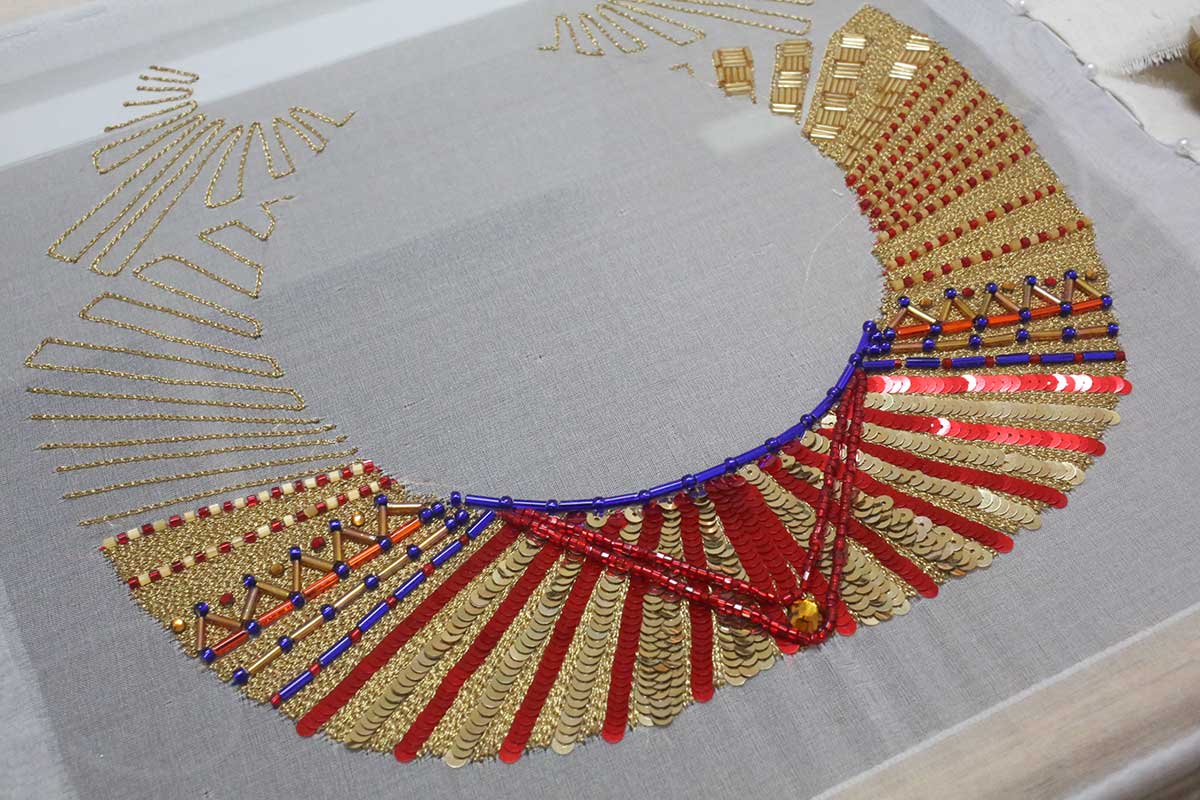THE COUTURE FASHION COLLECTION
Antiquities Inspired Dress
Inspired by Ancient Greek and Egyptian Costume and Jewellery Design
Ancient Egyptian Costume

It’s amazing to think that the history of draping and hand embroidery extends as far back as ancient Egypt. Costume worn by kings and dignitaries dating back to the Old Kingdom of 1500 BC featured hand draped clothing known as a schenti . It was made of loin cloth and held in place by a beaded girdle. During the time of the New Kingdom from 1500 BC to 332 BC, Egyptian clothing evolved into a tunic called the kelasiris. These were kept in place by a belt or band fastened around the waist or over the shoulder and were sometimes embroidered. Capes also appeared at this time and were worn by the Pharoahs with wide jewelled collars. Over a period of nearly three thousand years, Egyptian clothing changed little in terms of design. Draped clothing and ornamentation remained an important signifier to distinguish monarch and nobles from the lower classes.
Sources: (i) Laver, J. A Concise History of Costume. Thames and Hudson, London, 1969. (ii) Kohler, C. A History of Costume. Constable and Company Ltd, London, 1963. (iii) Image: Necklace of Princess Neferuptah, daughter of Amenemhet III, 12th Dynasty 1844-1797 BC. Source: TourEgypt.net.
Ancient Greek Costume

Ancient Greek costume comprised the chiton; a linen shirt worn mostly by the Ionians, the peplos; an upper garment of wool worn only by women and originally only by Dorian women, and a woollen cloak; the chlamys. Using various methods of girding and gathering a considerable number of styles could be achieved, each representing the identity of a tribe and region. The peplos of Dorian women was richly patterned and was worn as a tubular piece held in place at the shoulders and fitted around the waist with a girdle to reveal bare arms. The lower edge was finished with braid. The natural fall of linen fabric around the body created volume and style that could be easily manipulated into place. This mode of dress inspired me to work with plush soft jersey velvet. Rather than use the shoulders as the origin of the drapery, I chose the centre front of the neckline to drape the fabric from thus allowing the collar to be the main focus of the design. Rather than use a girdle to secure the fabric on the body, I designed and made an elasticised couture stay. It is drawn through loops on the inside of the dress and secured under the bust at front.
Sources: (i) Laver, J. A Concise History of Costume. Thames and Hudson, London, 1969. (ii) Kohler, C. A History of Costume. Constable and Company Ltd, London, 1963. (iii) Hansen, H.H. Costume Cavalcade. Methuen and Co Ltd, London, 1958. (iv) Image: Antiquities inspired tambour embroidery designed by Olivia Torma © 2020. All Rights Reserved.



